Nizar Zorba
Caching Through the Skies: The Case of LEO Satellites Connected Edges for 6G and Beyond
Mar 22, 2023Abstract:The deployment of low earth orbit (LEO) satellites with terrestrial networks can potentially increase the efficiency and reduce the cost of relaying content from a data center to a set of edge caches hosted by 6G and beyond enabled macro base stations. In this work, the characteristics of the communication system and the mobility of LEO satellites are thoroughly discussed to describe the channel characteristics of LEO satellites, in terms of their frequency bands, latency, Doppler shifts, fading effects, and satellite access. Three different scenarios are proposed for the relay of data from data centers to edge caches via LEO satellites, which are the "Immediate Forward", "Relay and Forward", and "Store and Forward" scenarios. A comparative problem formulation is utilized to obtain numerical results from simulations to demonstrate the effectiveness and validity as well as the trade-offs of the proposed system model. The simulation results indicate that the integration of LEO satellites in edge caching for 6G and beyond networks decreased the required transmission power for relaying the data from the data center to the edge caches. Future research directions based on the proposed model are discussed.
Terahertz Multiple Access: A Deep Reinforcement Learning Controlled Multihop IRS Topology
Mar 16, 2023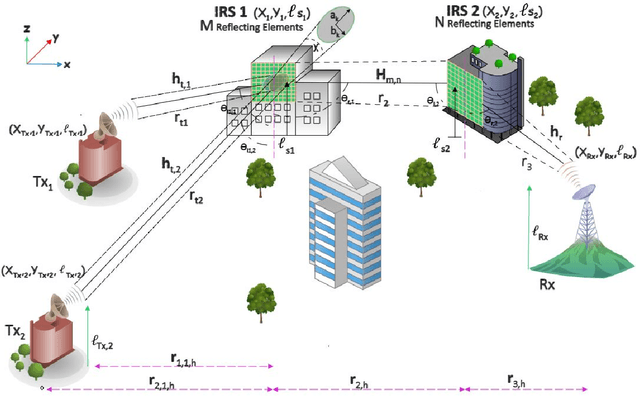
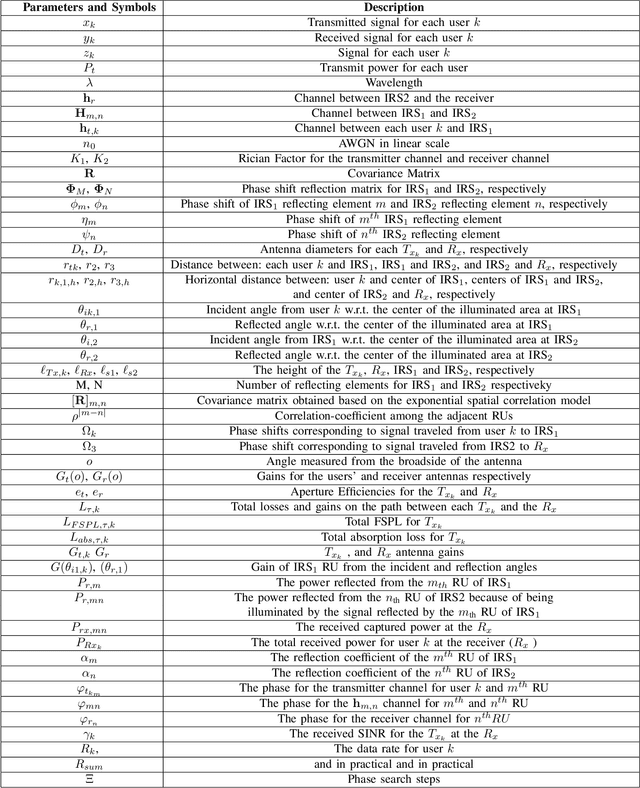
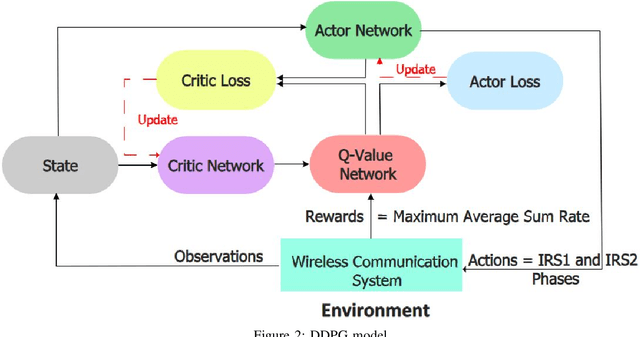
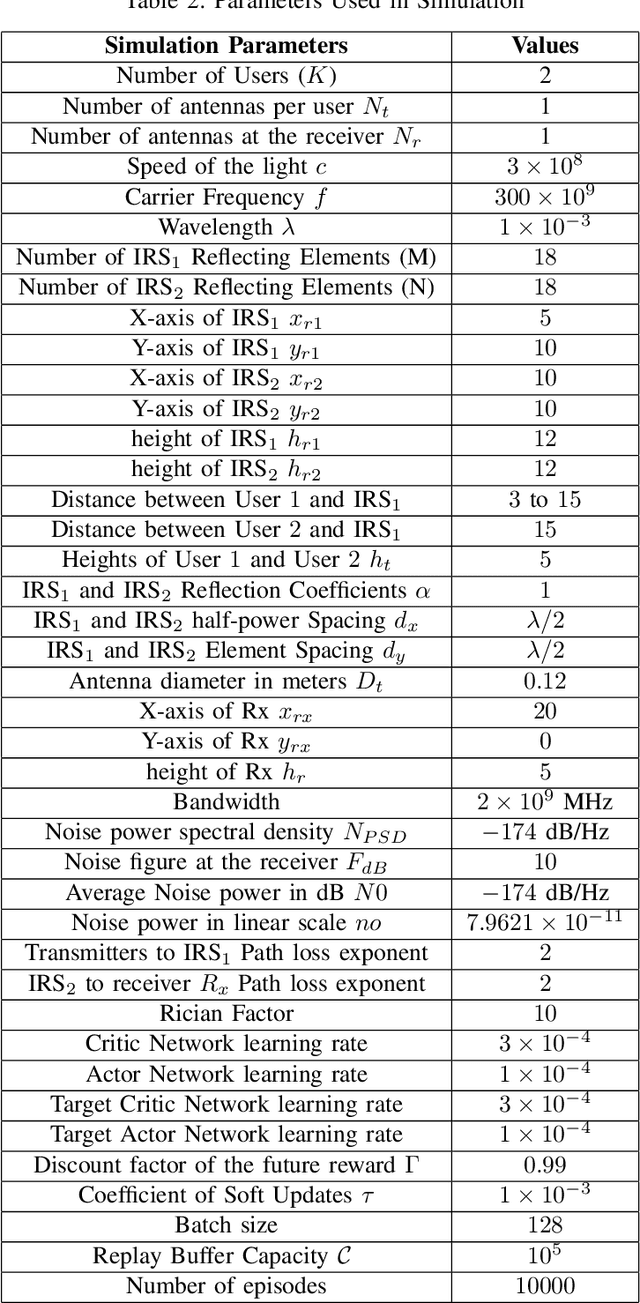
Abstract:We investigate THz communication uplink multiple access using cascaded intelligent reflecting surfaces (IRSs) assuming correlated channels. Two independent objectives to be achieved via adjusting the phases of the cascaded IRSs: 1) maximizing the received rate of a desired user under interference from the second user and 2) maximizing the sum rate of both users. The resulting optimization problems are non-convex. For the first objective, we devise a sub-optimal analytical solution by maximizing the received power of the desired user, however, this results in an over determined system. Approximate solutions using pseudo-inverse and block-based approaches are attempted. For the second objective, a loose upperbound is derived and an exhaustive search solution is utilized. We then use deep reinforcement learning (DRL) to solve both objectives. Results reveal the suitability of DRL for such complex configurations. For the first objective, the DRL-based solution is superior to the sub-optimal mathematical methods, while for the second objective, it produces sum rates almost close to the exhaustive search. Further, the results reveal that as the correlation-coefficient increases, the sum rate of DRL increases, since it benefits from the presence of correlation in the channel to improve statistical learning.
A General Model for Pointing Error of High Frequency Directional Antennas
Aug 30, 2022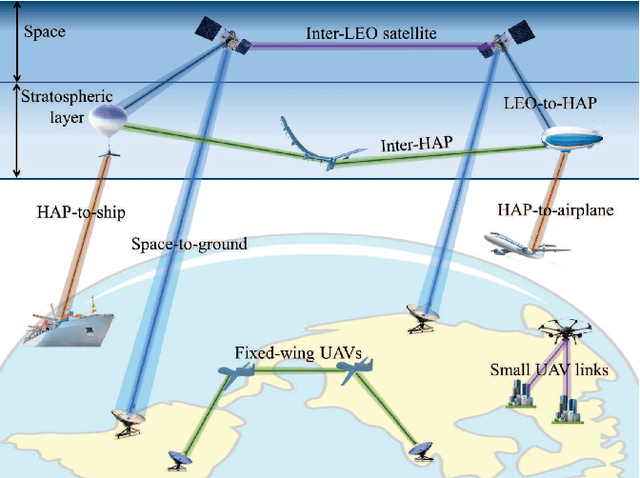
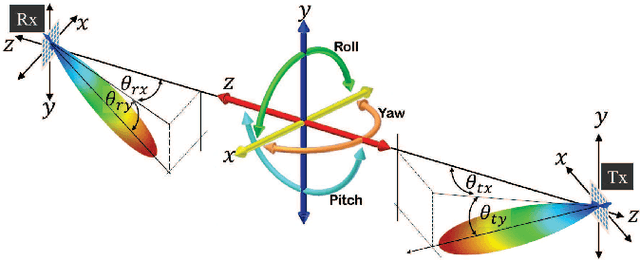
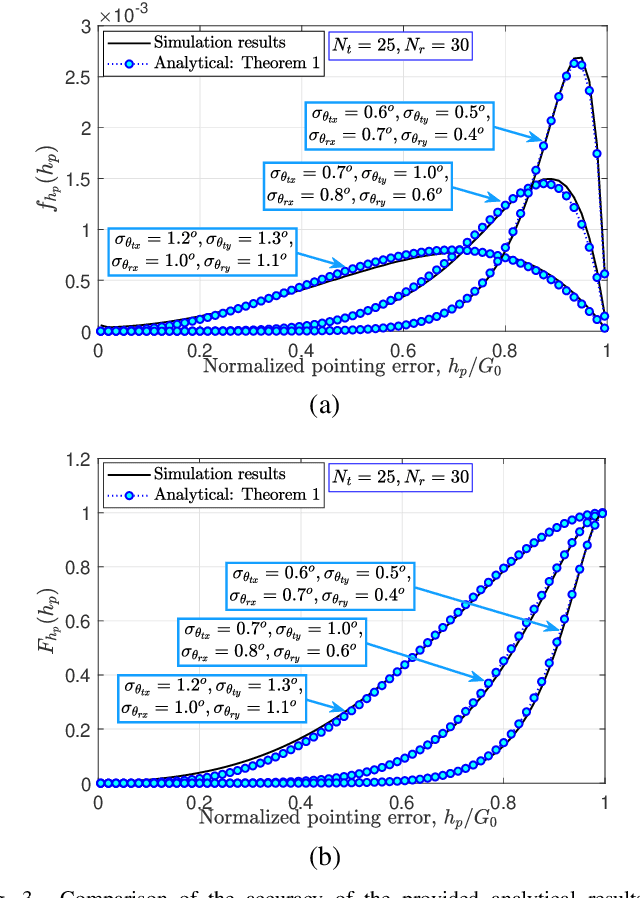
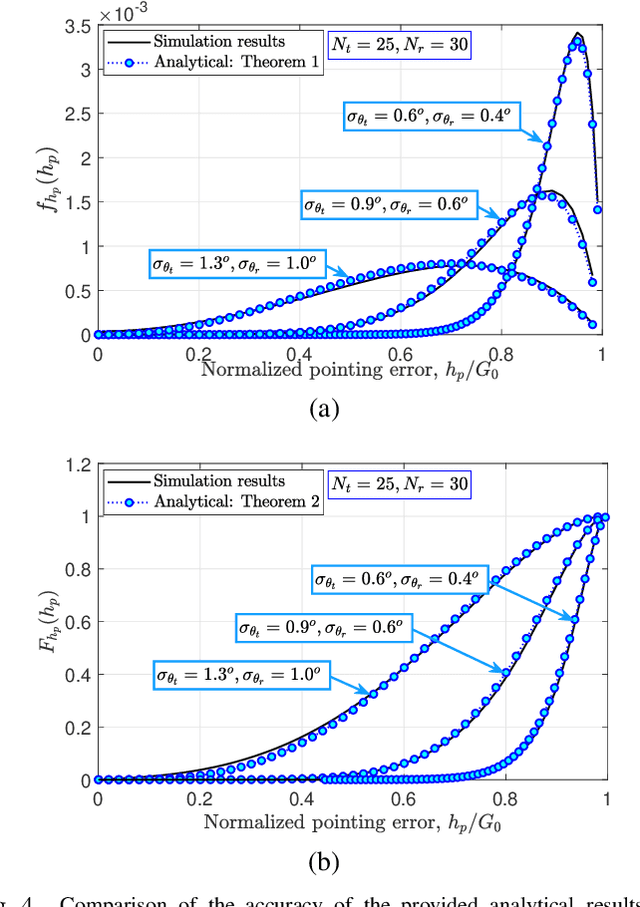
Abstract:This paper focuses on providing an analytical framework for the quantification and evaluation of the pointing error for a general case at high-frequency millimeter wave (mmWave) and terahertz (THz) communication links. For this aim, we first derive the the probability density function (PDF) and cumulative distribution functions (CDF) of the pointing error between an unstable transmitter (Tx) and receiver (Rx), that have different antenna patterns and for which the vibrations are not similar in the Yaw and Pitch directions. The special case where the Tx and Rx are both equipped with uniform linear array antenna is also investigated. In addition, using $\alpha-\mu$ distribution, which is a valid model for small-scale fading of mmWave/THz links, the end-to-end PDF and CDF of the considered channel is derived for all the considered cases. Finally, by employing Monte-Carlo simulations, the accuracy of the analytical expressions is verified and the performance of the system is studied.
Enabling Long mmWave Aerial Backhaul Links via Fixed-Wing UAVs: Performance and Design
Mar 15, 2022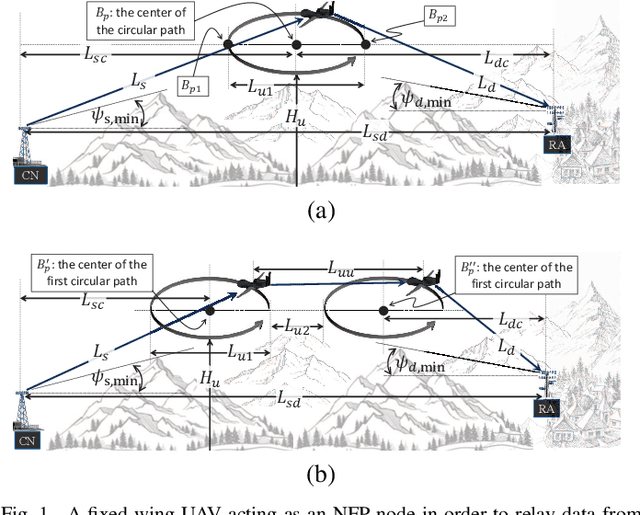
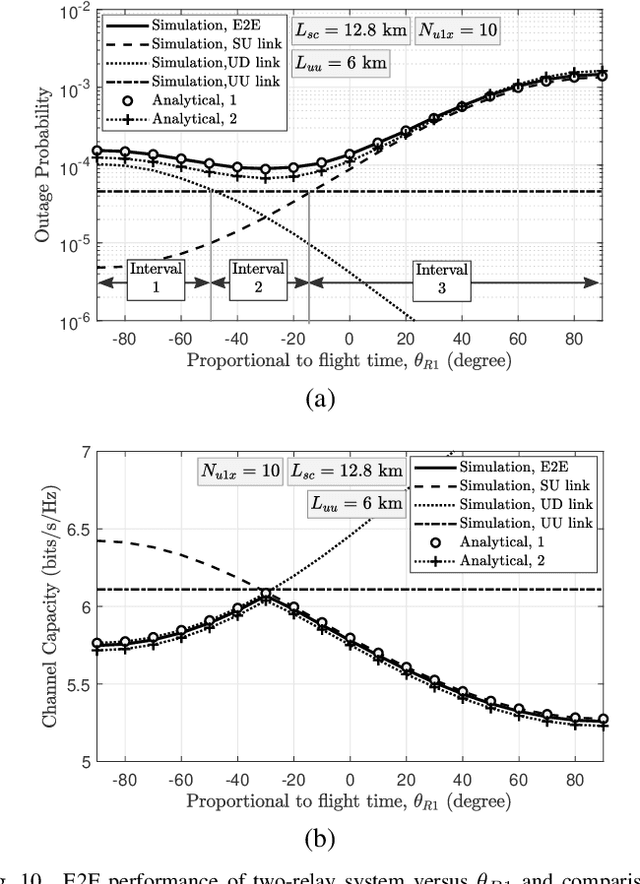
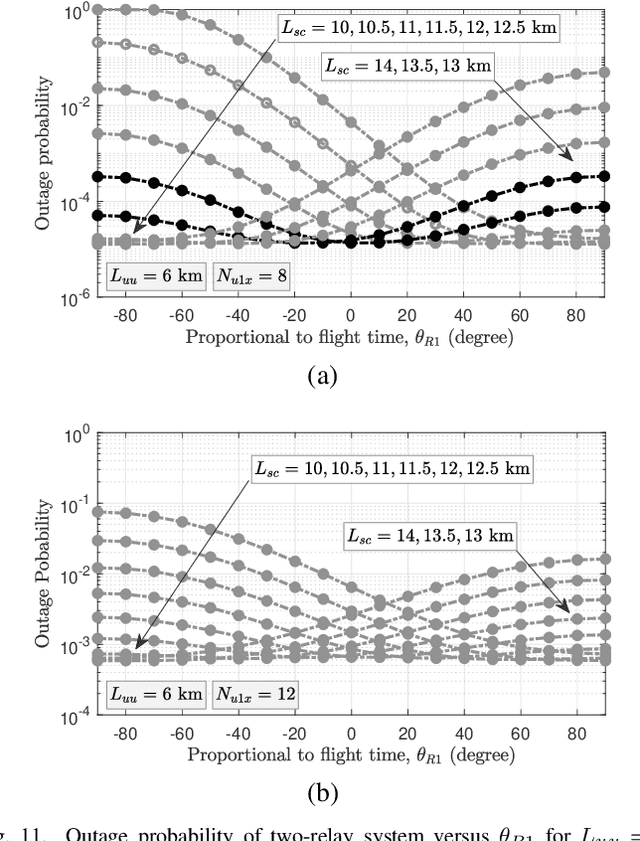
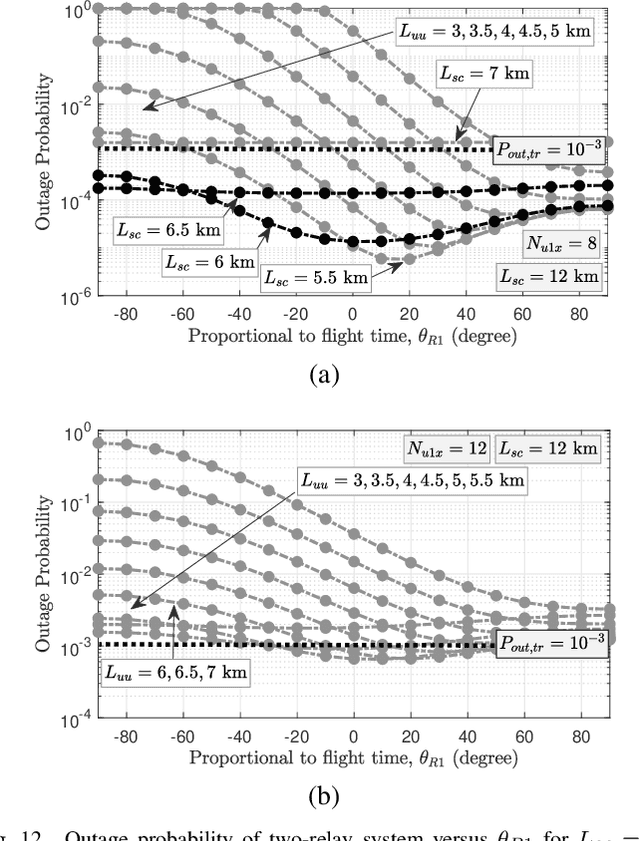
Abstract:We propose a fixed wing unmanned aerial vehicles (UAV)-based millimeter wave (mmWave) backhaul links, that is offered as a cost effective and easy to deploy solution, to connect a disaster or remote area to the nearest core network. First, we fully characterize the single relay fixed-wing UAV-based communication system by taking into account the effects of realistic physical parameters, such as the UAV's circular path, critical points of the flight path, heights and positions of obstacles, flight altitude, tracking error, the severity of UAV's vibrations, the real 3D antenna pattern, mmWave atmospheric channel loss, temperature and air pressure. Second, we derive the distribution of the signal-to-noise ratio (SNR) metric, which is based on the sum of a series of Dirac delta functions. Using the SNR distribution, we derive closed-form expressions for the outage probability and the ergodic capacity of the considered system as a function of all system parameters. To provide an acceptable quality of service for longer link lengths, we extend the analytical expressions to a multi-relay system. The accuracy of the closed-form expressions are verified by Monte-Carlo simulations. Finally, by providing sufficient simulation results, we investigate the effects of key channel parameters such as antenna pattern gain and flight path on the performance of the considered system; and we carefully analyze the relationships between these parameters in order to maximize the average channel capacity.
Long mmWave Backhaul Connectivity Using Fixed-Wing UAVs
Mar 08, 2022



Abstract:This paper discusses the analysis of a fixed-wing unmanned aerial vehicle (UAV)-based millimeter wave (mmWave) backhaul link, that is offered as a cost-effective and easy deploy the solution to connect a disaster or remote area to the nearest core network. We present the optimal design of a relay system based on fixed-wing UAV, taking into account the actual channel parameters such as the UAV vibrations, tracking error, real 3GPP antenna pattern, UAV's height, flight path, and the effect of physical obstacles. The performance of the considered system is evaluated in terms of outage probability and the channel capacity while taking into account the impact of the system parameters such as optimal selection of UAV flight path and antenna patterns.
iDriveSense: Dynamic Route Planning Involving Roads Quality Information
Sep 08, 2018



Abstract:Owing to the expeditious growth in the information and communication technologies, smart cities have raised the expectations in terms of efficient functioning and management. One key aspect of residents' daily comfort is assured through affording reliable traffic management and route planning. Comprehensively, the majority of the present trip planning applications and service providers are enabling their trip planning recommendations relying on shortest paths and/or fastest routes. However, such suggestions may discount drivers' preferences with respect to safe and less disturbing trips. Road anomalies such as cracks, potholes, and manholes induce risky driving scenarios and can lead to vehicles damages and costly repairs. Accordingly, in this paper, we propose a crowdsensing based dynamic route planning system. Leveraging both the vehicle motion sensors and the inertial sensors within the smart devices, road surface types and anomalies have been detected and categorized. In addition, the monitored events are geo-referenced utilizing GPS receivers on both vehicles and smart devices. Consequently, road segments assessments are conducted using fuzzy system models based on aspects such as the number of anomalies and their severity levels in each road segment. Afterward, another fuzzy model is adopted to recommend the best trip routes based on the road segments quality in each potential route. Extensive road experiments are held to build and show the potential of the proposed system.
Design, Development and Evaluation of a UAV to Study Air Quality in Qatar
Sep 17, 2017



Abstract:Measuring gases for air quality monitoring is a challenging task that claims a lot of time of observation and large numbers of sensors. The aim of this project is to develop a partially autonomous unmanned aerial vehicle (UAV) equipped with sensors, in order to monitor and collect air quality real time data in designated areas and send it to the ground base. This project is designed and implemented by a multidisciplinary team from electrical and computer engineering departments. The electrical engineering team responsible for implementing air quality sensors for detecting real time data and transmit it from the plane to the ground. On the other hand, the computer engineering team is in charge of Interface sensors and provide platform to view and visualize air quality data and live video streaming. The proposed project contains several sensors to measure Temperature, Humidity, Dust, CO, CO2 and O3. The collected data is transmitted to a server over a wireless internet connection and the server will store, and supply these data to any party who has permission to access it through android phone or website in semi-real time. The developed UAV has carried several field tests in Al Shamal airport in Qatar, with interesting results and proof of concept outcomes.
 Add to Chrome
Add to Chrome Add to Firefox
Add to Firefox Add to Edge
Add to Edge